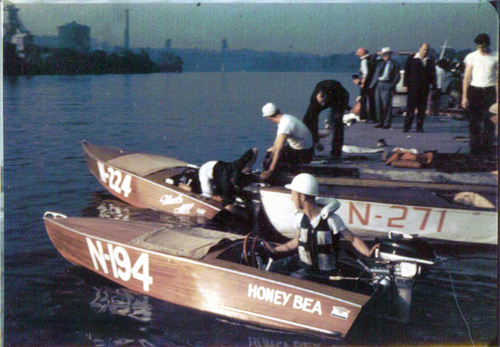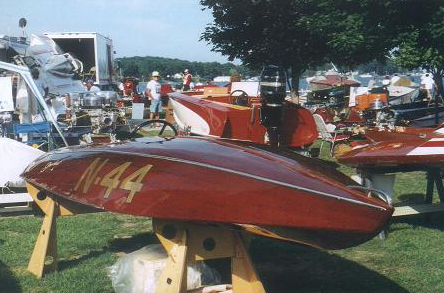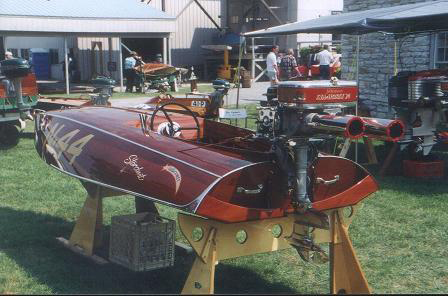
| Stew Sill and Willis Boats |
A Brief History Stew Sill's shop on Sodus Bay, Lake Ontario, looks more like a cottage on Cape Cod than a workshop. The day we were there, a classic Chris Craft occupied much of the available floor space. The boat was stripped bare, and some frames and battens were being prepared for re-planking. But the real story hovered overhead. Stew did well, and became the high point champ in 1953 and 1954. One year, he even won Nationals and set a new speed record, but both those distinctions were taken away when his boat came in a half-pound under weight. Stew continued racing through the 1957 season, and then decided to leave the sport for a slightly safer lifestyle. As the years went by, Stew didn't think much about his first winning boat, the Willis Flying Saucer, until sometime in the '80s when his friend, George McDougall, came across a Flying Saucer for sale and began describing it to Stew. "The more he told me about it, the more I began to believe that it was my boat," Stew recalls. Stew resisted the temptation to buy her, but was soon surprised by George, who had bought her on the firm belief that Stew should own her once again. George gave the boat to Stew, and a full restoration ensued. "Honey Bea" made her modern age debut at the first Clayton Vintage Race Boat Regatta in August of 1992.
Stew adds, "Although very few parts of the original boat were suitable to re-use, I still consider it a restoration rather than a replica. The stem, a few frame parts, and parts of the transom were re-used and the rest were replaced very precisely with the same materials Willis used, All of the castings and trim parts made by Willis were refurbished and re-used. Period correct steering and throttle controls were found and installed. The engine is a Johnson PR-65 ,highly modified and runs on alcohol/castor oil mix. This is the engine the boat was designed for ( C Racing Runabout)." "The boat has NEVER been in the water, but if it were launched, it would take you for a 60 mile an hour ride! Not bad for a 1949 boat!!" Unlike the plywood-on-frame Flying Saucer, the Comet is a solid mahogany-planked boat, hull, sides, and deck. All seams are battened and the boat is a real mahogany jewel. Countless hours went into the restoration, since all new planking and even parts of the transom need to be fabricated and fitted to the frame. Stew restored the Comet to Pop Willis' exacting standards. The Comet made its way to the Clayton Vintage Race Boat Regatta in 2006 and now is in a prominent position in a private collection in New Hampshire. Click here for a slideshow of the restoration.
|
 Stew had actually begun his racing career in earnest in 1950 in this very boat. He acquired it after it had a very successful racing season in 1949, including the fabled Hudson River Marathon. Stew went on to race not only B class stock outboards, but also runabouts, hydros and some A class boats.
Stew had actually begun his racing career in earnest in 1950 in this very boat. He acquired it after it had a very successful racing season in 1949, including the fabled Hudson River Marathon. Stew went on to race not only B class stock outboards, but also runabouts, hydros and some A class boats.


